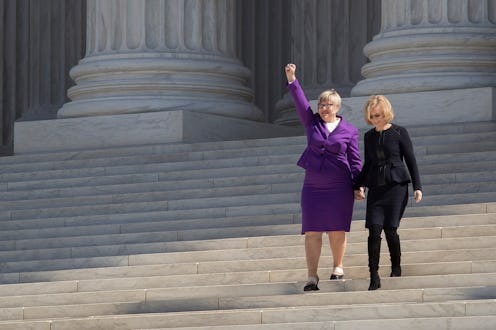News
12 Groundbreaking Moments For Reproductive Rights
Reproductive rights have never been a done deal in the United States, and we're still fighting battle after battle to keep the ones we have and expand on those we don't. This includes access to contraception and safe, legal abortion. But many past battles have been won by women and allies who refused to believe and behave as though women should not control their bodies and their lives. There are several groundbreaking moments in the fight for reproductive rights in our nation's history that highlight the obstacles women have faced as well as the victories their self-assertion has garnered.
The National Abortion Federation reported that, prior to the 1800s, abortions performed before the time of "quickening," or about the fourth month of pregnancy, were both legal and common. But beginning in the 19th century, states began passing legislation to restrict women's access to the procedure. Access to contraceptives was also restricted at that time. Today, several states continue to place burdensome restrictions on access to the procedure and to quality education about contraceptives in their schools.
There is no shortage of work left to be done. But we ought not forget the work, and the success, of those who came before. The following events were highly significant in advancing women's reproductive rights.
Pre-Civil War: Black Women Resist
The organization Trust Black Women reported that black women held in slavery made use of contraceptive and abortifacient knowledge and devices they kept secret from those who enslaved them to prevent pregnancy and childbirth. Whereas their so-called "masters" wanted them to make more "slave" children, many black women resisted, and they spread their knowledge through shared literature.
1855: First Rubber Condom
Eleven years after Charles Goodyear patented vulcanized rubber, the first rubber condom was produced. Baller move toward preventing unwanted pregnancy and the spread of infections, but unfortunately, the Comstock Act of 1873 quickly made contraceptives illegal. It would be about a century until access to contraceptives was not legally restricted.
1916: The First Birth Control Clinic
Margaret Sanger reportedly had some problematic eugenics views. But she also opened the first birth control clinic, in defiance of the Comstock Act. She was arrested for that, but opened another one when she got out of jail. She's a big reason why Planned Parenthood exists today.
1918-1920s: Black Leaders Talk Birth Control
In defiance of the Comstock Act, the Women's Political Association of Harlem and the New York Urban League began holding educational sessions on birth control, reported Trust Black Women. The enthusiasm generated by the sessions led to the development of birth control clinics in black communities.
1960: First Oral Contraceptive
The Food and Drug Administration approved the first oral contraceptive in the United States in 1960. Not that women could take it for that express purpose — Comstock is still in play!
1965: Contraceptives Allowed, For Married Couples
Almost 100 years after Comstock, the Supreme Court ruled, in Griswold v. Connecticut, that women could legally use contraceptives for the purpose of preventing pregnancy, so long as they were married.
1969: Speakout Against Stigma
Women telling their stories and speaking openly about abortion experiences is a powerful method of countering the stigma and demonization that too often come along with discussion of reproductive rights. In 1969, amid talks of abortion law reform, the first Speakout was held, and many have been organized since.
1972: Okay, Single Ladies, Too
In Baird v. Eisenstadt, the Supreme Court came around to the idea that unmarried women have a right to prevent unwanted pregnancies. The ruling finally did away with the Comstock Act's restrictions on legal access to contraceptives.
1973: Roe v. Wade
Of course, no list of groundbreaking reproductive rights moments would make sense without this Supreme Court decision, which protected access to abortion up to a certain point of pregnancy as a fundamental issue of privacy, and discouraged states from putting restrictions on the procedure beyond that point if a woman's health is in danger.
1986: Undoing A Terrible Protocol
A Pennsylvania law required abortion providers to use a technique for administering the procedure that made it most likely that the fetus would survive. In 1986, the Supreme Court struck it down in Thornburgh v. American College of Obstetricians and Gynecologists.
2004: March For Women's Lives
A record-breaking 1.15 million women turned out for the March for Women's Lives in 2004, organized by a number of women's organizations, to protest the positions on reproductive rights espoused by George W. Bush's administration.
2013: Plan B Goes OTC
Emergency contraceptives are a time-sensitive thing. Starting in 2013, women and girls no longer needed to go through the process of getting a prescription for Plan B and could instead receive it over the counter.
Though not an exhaustive list, the court cases, acts of resistance, and inventions walk us through where the fight for reproductive rights has been. As we continue to resist attempts by states to pass greater restrictions on abortion access and encourage continued access to contraceptives as well as better sex education, the work for reproductive justice is expanding more seriously than ever into efforts toward paid family leave and affordable child care for women who do choose to have children.
The connecting theme: Women have a right to our bodies and our lives, a message that needs to be spoken as loudly now as before.
